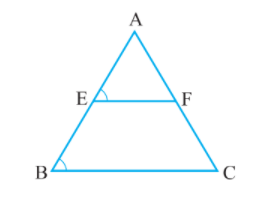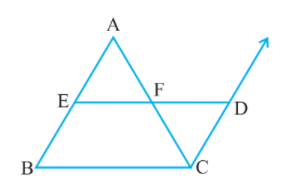QUADRILATERALS for Class 9 MATHS
INTRODUCTION
Bacchon, jab hum apne charo taraf dekhte hai to hum pate hai ki aise bahut sare objects hai jinme four sides and four corners hote hai for example : the floor, walls, ceiling, windows of your classroom, the blackboard etc. So guys, aapne previous chapter me triangles and unke properties ke bare me pdha hai jisme three sides and three vertices hote the. Lakin es chapter me hum aise figures and unke properties ke bare me padhne wale hai jinke four sides and four vertices hote hai jinhe quadrilaterals kha jata hai. In this chapter, we will study more about different types of quadrilaterals, their properties and especially those of parallelograms. Although most of the objects we see around are of the shape of a special quadrilateral called a rectangle, we shall study more about quadrilaterals and especially parallelograms because a rectangle is also a parallelogram and all properties of a parallelogram are true for a rectangle as well.
Angle Sum Property of a Quadrilateral
The sum of the angles of a quadrilateral is 360∘.
Explanation
So bacchon, verify karne ke liye let us assume a quadrilateral ABCD. Now, draw a diagonal AC jo quadrilateral ko two triangles me divide karta hai.

Here in △ADC
∠DAC+∠ACD+∠D=180° [Angle sum property of triangle]
Similarly in △ABC
∠CAB+∠ACB+∠B=180° [Angle sum property of triangle]
Now, adding both the above equations
∠DAC+∠ACD+∠D+∠CAB+∠ACB+∠B=180°+180°=360°
Here, ∠DAC+∠CAB=∠Aand∠ACD+∠ACB=∠C
∴∠A+∠D+∠B+∠C=360°.
So guys, humne dekha ki kise bhi quadrilaterals ke angles ka sum 360∘ hota hai.
Types of quadrilaterals
Jaisa ki hum jante hai quadrilaterals are those figures in which we have four sides and four vertices. Look at the different quadrilaterals drawn below :

Upar hum bahut sare quadrilaterals ke example dekh sakte hai jinki alag alag properties hai. So guys, if we go through these figures one by one we can observe that :
Note :
(1) Square, rectangle and rhombus are all parallelograms.
(2) A square is a rectangle and also a rhombus.
(3) A parallelogram is a trapezium.
(4) A kite is not a parallelogram.
(5) A trapezium is not a parallelogram (as only one pair of opposite sides is parallel in a trapezium and we require both pairs to be parallel in a parallelogram).
(6) A rectangle or a rhombus is not a square.
Properties of a Parallelogram
There are few properties of Parallelogram jinme se kuch ke bare humne previous classes me bhi pdha hai. Is chapter me hum en properties ko detail me, as a theorem padhenge and also we will prove some of them jo aksar aapke exams me bhi puch liye jate hai.
Theorem 8.1 :
A diagonal of a parallelogram divides it into two congruent triangles.
Let ABCD be a parallelogram and AC be a diagonal.

AC divides parallelogram ABCD into two triangles, namely, ΔABC and ΔCDA. We need to prove that these triangles are congruent.
In △ABC and △CDA we observe that BC∣∣AD and AC is a transversal.
∴∠BCA=∠DAC [Alternate interior angles]
Similarly AB∣∣DC and AC is a transversal.
∴∠BAC=∠DCA [Alternate interior angles]
And AC=CA [Common]
∴ΔABC≅ΔCDA [ASA rule ]
So we have proved that diagonal AC divides parallelogram ABCD into two congruent triangles ABC and CDA.
Theorem 8.2 :
In a parallelogram, opposite sides are equal.
So guys, jaisa ki humne previous theorem me dekha hai ki diagonal divides the parallelogram in two congruent triangles.

As we know that corresponding parts of congruent triangles are also same.
So, AB=DCandAD=BC
Theorem 8.3 :
If each pair of opposite sides of a quadrilateral is equal, then it is a parallelogram.
Let us consider a quadrilateral ABCD.

It is given that sides ABandCD of the quadrilateral ABCD
be equal and also AD=BC.
In △ABCand△CDA,
AB=CD [given]
BC=DA [given]
And AC=AC [common]
∴△ABC≅△CDA [SSS rule]
So, ∠BAC=∠DCA [C.P.C.T.] ,
and ∠BCA=∠DAC [C.P.C.T] .
So guys jaisa ki hum yha dekh sakte hai AC ia a transversal for AB and CD and we have proved that alternate interior angles are same so AB∣∣CD.
Similarly AC is a transversal for BC and DA and alternate interior angles are same so BC∣∣DA.
Hence, ABCD is a parallelogram.
Theorem 8.4 :
In a parallelogram, opposite angles are equal.
Let us consider a parallelogram ABCD.

Guys jaisa ki humne theorem 8.1 me dekha hai ki a diagonal divides a parallelogram into two congruent triangles. Which means for diagonal AC,
ΔABC≅ΔCDA
Since corresponding parts of congruent triangles are same therefore
∠D=∠B
Similarly if we draw a diagonal BD we can easily prove that △ABD≅△CDB.
Well, in that case ∠A=∠C.
∴ Each pair of opposite angles is equal.
Theorem 8.5 :
If in a quadrilateral, each pair of opposite angles is equal, then it is a parallelogram.
This is the reverse of the previous theorem.
Theorem 8.6 :
The diagonals of a parallelogram bisect each other.
Let us consider a parallelogram ABCD where AC is a diagonal .

Here we have to prove that OA=OC and OB=OD .
Since we have AD∣∣CB and BD and AC work as transversals.
⇒∠ADO=∠CBO [alternate interior angles]
Similarly ∠OCB=∠OAD [alternate interior angles]
AD=BC [opposite sides are equal in a parallelogram]
∴△AOD≅△COB [ASA rule]
Therefore from CPCT OA=OC and OB=OD proved.
Theorem 8.7 :
If the diagonals of a quadrilateral bisect each other, then it is a parallelogram.
Let us consider a quadrilateral ABCD in which AC and BD are two diagonals such that OA=OC and OB=OD

Here we have to prove that AB∣∣CD and BC∣∣AD
In △AOD and △COB
OA=OC [given]
OB=OD [given]
∠AOD=∠COB [opposite angles ]
∴△AOD≅△COB
⇒∠ABO=∠CDO [CPCT]
Here we can see that alternate interior angles are same
∴AB∣∣CD
Similarly ∠OAD=∠OCB [CPCT]
∴BC∣∣AD [because alternate interior angles are same]
Therefore we can conclude that ABCD is a parallelogram.
Example 1
Show that the diagonals of a rhombus are perpendicular to each other.
Consider the rhombus ABCD, such that AC and BD are two diagonals. They cut each other at point O.

We know that for a rhombus AB=BC=CD=DA
Now, in ΔAOD and ΔCOD,
OA=OC [Diagonals of a parallelogram bisect each other]
OD=OD [Common]
and AD=CD
∴ΔAOD≅ΔCOD [SSS congruence rule]
This gives, ∠AOD=∠COD [CPCT]
But, ∠AOD+∠COD=180° [Linear pair]
∴2∠AOD=180°
⇒∠AOD=90°
So guys, finally we can conclude that the diagonals of a rhombus are perpendicular to each other.
Example 2
ABC is an isosceles triangle in which AB=AC. AD bisects exterior angle PAC and CD∣∣AB. Show that (i)∠DAC=∠BCA and (ii) ABCD is a parallelogram.

(i) ΔABC is isosceles in which AB=AC [Given]
∴∠ABC=∠ACB [Angles opposite to equal sides]
Also, ∠PAC=∠ABC+∠ACB [Exterior angle of a triangle]
∴∠PAC=2∠ACB …………(i)
Now, hume pta hai AD bisects ∠PAC.
So, ∠PAC=2∠DAC...........(ii)
∴2∠DAC=2∠ACB [From (1) and (2)]
⇒∠DAC=∠ACB
(ii) Now, these equal angles form a pair of alternate angles when line segments BC and AD are intersected by a transversal AC .
So, BC∣∣AD
Also, BA∣∣CD [Given]
∴ABCD is a parallelogram.
Example 3
Two parallel lines l and m are intersected by a transversal p.

Show that the quadrilateral formed by the bisectors of interior angles is a rectangle.
It is given that PS∣∣QR and transversal p intersects them at points A and C respectively .
The bisectors of ∠PAC and ∠ACQ intersect at B and bisectors of ∠ACR and ∠SAC intersect at D.
Hume ye prove karna hai ABCD is a rectangle.
Now, ∠PAC=∠ACR [Alternate angles as l∣∣m and p is a transversal]
So,12∠PAC=12∠ACR
∴∠BAC=∠ACD
Guys, yha hum dhyan denge these form a pair of alternate angles for lines AB and DC with AC as transversal and
they are equal also.
∴AB∣∣DC
Similarly, BC∣∣AD [Considering ∠ACB and ∠CAD]
∴ Quadrilateral ABCD is a parallelogram.
Now, ∠PAC+∠CAS=180° [Linear pair]
∴(12)∠PAC+(12)∠CAS=(12)×180°=90°
Or ∠BAC+∠CAD=90°
∴∠BAD=90°
So, ABCD is a parallelogram in which one angle is 90°.
Therefore, ABCD is a rectangle.
Theorem 8.8 :
A quadrilateral is a parallelogram if a pair of opposite sides is equal and parallel.
Let us consider a quadrilateral ABCD.

Here we have given that AB=CD and AB∣∣CD.
Let us draw a diagonal AC.
So, AB=CD [given]
∠BAC=∠DCA [ AB∣∣CD and AC is a transversal]
AC=AC [common]
∴ ΔABC≅ΔCDA by SAS congruence rule.
∴∠CAD=∠ACB [CPCT]
Since these angles are alternate interior angles for AC as a transversal for two lines AD and BC.
∴AD∣∣BC
Hence we can conclude that ABCD is a parallelogram.
Example 4
ABCD is a parallelogram in which P and Q are mid-points of opposite sides AB and CD(see Fig.) . If AQ intersects DP at S and BQ intersects CP at R, show that : APCQ is a parallelogram.

In quadrilateral APCQ,
AP∣∣QC [Since AB || CD]..........(i)
also AP=12AB and CQ=12CD [given]
also AB=CD [opposite sides of parallelogram are equal]
∴AP=QC.............(ii)
Therefore From (i) and (ii) and Theorem 8.8 we can say that
APCQ is a parallelogram.
The Mid-point Theorem [Theorem 8.9]
Statement : The line segment joining the mid-points of two sides of a triangle is parallel to the third side.

Let us consider a triangle ABC such that E and F are mid-points of AB and AC respectively.

CONSTRUCTION : Draw CD such that CD || BA .
We have to prove that EF∣∣BC
Now we have
AE=EB [E is mid point of AB]
AF=FC [F is mid point of AC]
In △AEF and △CDF
∠EAF=∠DCF [alternate interior angles]
AF=FC
∠AFE=∠CFD [vertically opposite angle ]
∴△AEF=△CDF [ASA rule]
But guys agar hum yha dhyan de to hum observe karte hai
AE=CD [CPCT]
and AE=EB [given]
∴EB=CD
and also EB∣∣CD [construction]
So guys jaisa ki hum jante hai agar kisi quadrilateral me two opposite sides parallel and equal hote hai to that quadrilateral is nothing but a parallelogram.
⇒ED∣∣BC
Or,EF∣∣BC [Proved]
Theorem 8.10 :
The line drawn through the mid-point of one side of a triangle, parallel to another side bisects the third side.
Let us consider a triangle ABC such that E is the mid-point of
AB , line l is passing through E and is parallel to BC and CM∣∣BA .

Here we have to prove that AF=CF.
Taking △AEFand△CDF
Here , ∠EAF=∠DCF [alternate interior angles]
EB=CD [construction]
and EB=EA [given]
⇒EA=CD
Also ∠AFE=∠CFD [vertically opposite angles]
∴△AFE≅△CFD
So with the property of CPCT hum ye conclude kar sakte hai
AF=FC
⇒F is the midpoint of AC.
Example 5
In ΔABC,D,EandF are respectively the mid-points of sides AB, BC and CA (see Fig.). Show that ΔABC is divided into four congruent triangles by joining D,EandF.

As D and E are mid-points of sides AB
and BC of the triangle ABC, by Theorem 8.9,
DE∣∣AC
Similarly DF||BCandEF||AB
Therefore ADEF,BDFEandDFCE are all parallelograms.
Now DE is a diagonal of the parallelogram BDFE,
∴ΔBDE≅ΔFED
Similarly ΔDAF≅ΔFED
and ΔEFC≅ΔFED
So, all the four triangles are congruent.
Summary
In this chapter, you have studied the following points :
1. Sum of the angles of a quadrilateral is 360°.
2. A diagonal of a parallelogram divides it into two congruent triangles.
3. In a parallelogram,
(i) opposite sides are equal
(ii) opposite angles are equal
(iii) diagonals bisect each other.
4. A quadrilateral is a parallelogram, if one of the following condition satisfied :
(i) opposite sides are equal
(ii) opposite angles are equal
(iii) diagonals bisect each other
(iv) a pair of opposite sides is equal and parallel
5. Diagonals of a rectangle bisect each other and are equal and vice-versa .
6. Diagonals of a rhombus bisect each other at right angles and vice-versa .
7. Diagonals of a square bisect each other at right angles and are equal, and vice-versa.
8. The line-segment joining the mid-points of any two sides of a triangle is parallel to the
third side and is half of it.
9. A line through the mid-point of a side of a triangle parallel to another side bisects the third
side.
10. The quadrilateral formed by joining the mid-points of the sides of a quadrilateral, in order,
is a parallelogram.